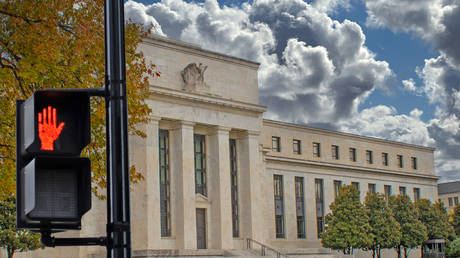Another Bad Sign for the Economy: Wholesale Inventories Surge Again
by Peter Schiff, Schiff Gold:
 On Friday, the yield curve inverted, often a warning sign of an impending recession. Many mainstream pundits say we shouldn’t be concerned about the inversion and that the US economy is still healthy. They say there are other underlying reasons for the inverted yield curve. But there are plenty of other economic data points that are flashing recession warnings. For instance, inventories are piling up in warehouses.
On Friday, the yield curve inverted, often a warning sign of an impending recession. Many mainstream pundits say we shouldn’t be concerned about the inversion and that the US economy is still healthy. They say there are other underlying reasons for the inverted yield curve. But there are plenty of other economic data points that are flashing recession warnings. For instance, inventories are piling up in warehouses.
Wholesale inventories surged again in January, according to the latest Commerce Department data.
This comes on the heels of the largest gain in wholesale inventories in more than five years in December.
Inventories rose 7.7% from a year ago in January. Meanwhile, sales only rose by 2.7%. Overall, total inventories were $669.9 billion at the end of January, up 1.2% from the revised December level.
The increase in durable goods inventories at the wholesale level was even starker. These inventories were up 11.7% from January a year ago, and are up 17% from January two years ago, hitting $415 billion, the highest ever. Sales of durable goods were up 4.7% but as Wolf Street explains, the important number is the inventory-to-sales ratio — and it’s not good.
The inventory-to-sales ratio for durable goods rose to 1.69 in January, the highest ratio since August 2016, back when the goods-based sector was coming out of the last inventory pileup that had led to the recession in the goods-based sector that had dragged down overall economic growth for 2016 to just 1.6%, the worst since the Financial Crisis.”
The service sector kept the US economy from falling into a recession during the last durable goods slowdown.
An inventory pileup is a leading indicator of economic activity. It indicates that things are slowing down. People aren’t buying stuff and it’s piling up in warehouses. Eventually, this will ripple back through the economy, as Wolf Street explains.
When inventories pile up, sales by those companies that supply that inventory do well. But companies that sit on that inventory and have trouble selling it will at some point cut their orders to reduce their inventories. When this happens, sales drop all the way up the supply chain.”
An article published by FX Steet features a quote from Econoday that puts the inventory numbers in stark terms.
There are few indications of economic slowing that are more convincing than an unwanted build in inventories — and that apparently is what’s underway in the wholesale sector. Wholesale inventories jumped 1.2% in January to far exceed anyone’s expectations and are up 7.7% year-on-year. Confirmation that this is unwanted comes from sales in the sector which did rise 0.5 percent in January but follow a long stretch of contraction. Year-on-year, sales are up only 2.7%. The sector’s stock-to-sales ratio continues to climb, at 1.34 vs 1.33 in December and against 1.28 in January last year. Today’s data confirm the wisdom of the Federal Reserve’s cautious outlook.”
Loading...



